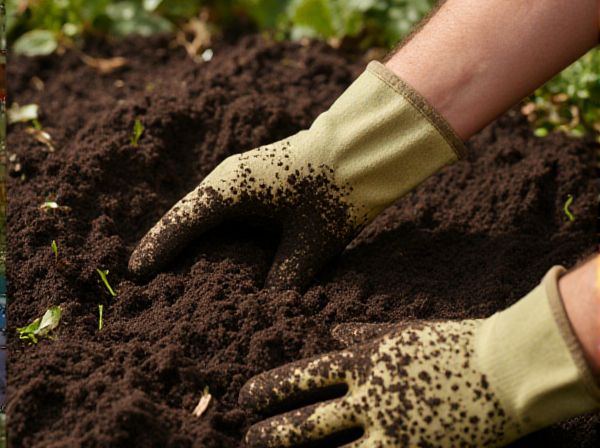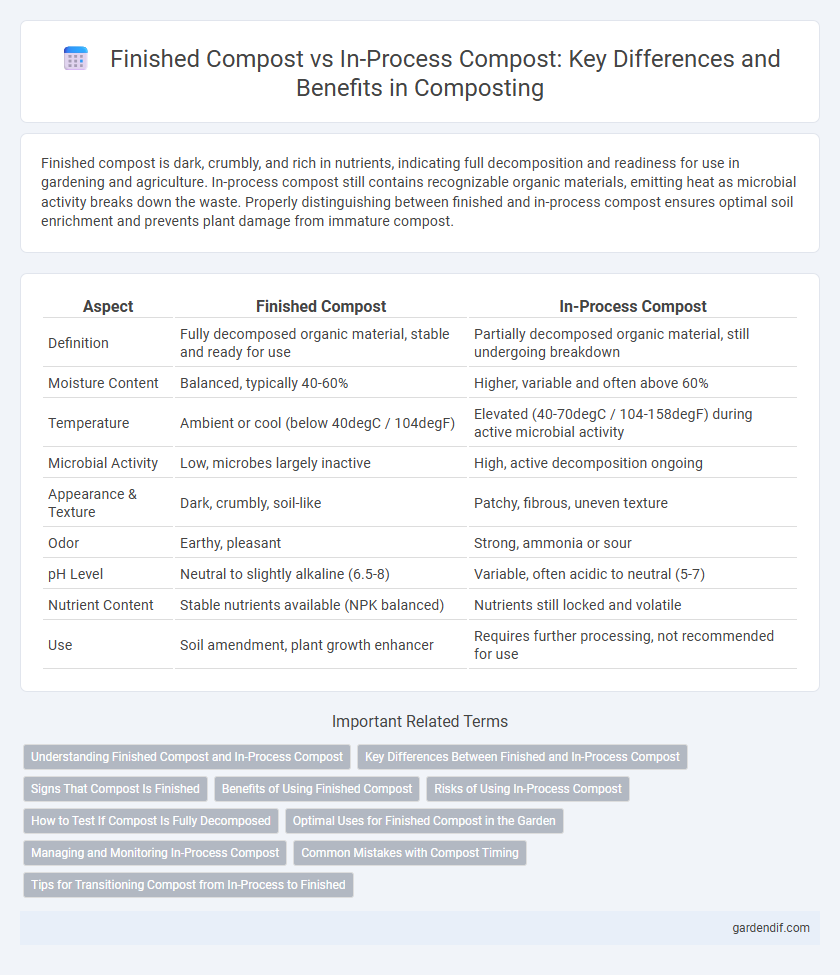
Finished Compost vs In-Process Compost Illustration
Finished compost is dark, crumbly, and rich in nutrients, indicating full decomposition and readiness for use in gardening and agriculture. In-process compost still contains recognizable organic materials, emitting heat as microbial activity breaks down the waste. Properly distinguishing between finished and in-process compost ensures optimal soil enrichment and prevents plant damage from immature compost.
Table of Comparison
| Aspect | Finished Compost | In-Process Compost |
|---|---|---|
| Definition | Fully decomposed organic material, stable and ready for use | Partially decomposed organic material, still undergoing breakdown |
| Moisture Content | Balanced, typically 40-60% | Higher, variable and often above 60% |
| Temperature | Ambient or cool (below 40degC / 104degF) | Elevated (40-70degC / 104-158degF) during active microbial activity |
| Microbial Activity | Low, microbes largely inactive | High, active decomposition ongoing |
| Appearance & Texture | Dark, crumbly, soil-like | Patchy, fibrous, uneven texture |
| Odor | Earthy, pleasant | Strong, ammonia or sour |
| pH Level | Neutral to slightly alkaline (6.5-8) | Variable, often acidic to neutral (5-7) |
| Nutrient Content | Stable nutrients available (NPK balanced) | Nutrients still locked and volatile |
| Use | Soil amendment, plant growth enhancer | Requires further processing, not recommended for use |
Understanding Finished Compost and In-Process Compost
Finished compost exhibits a dark, crumbly texture with a rich earthy aroma, indicating the breakdown of organic materials into stable, nutrient-rich humus suitable for soil enrichment. In-process compost contains identifiable organic matter and retains higher moisture and heat levels due to ongoing microbial activity, signaling incomplete decomposition. Understanding these stages ensures proper timing for compost application to maximize soil health and plant growth benefits.
Key Differences Between Finished and In-Process Compost
Finished compost is dark, crumbly, and odor-free, indicating full decomposition and nutrient stability suitable for plant use. In-process compost contains recognizable organic materials with uneven texture and a strong, often ammonia-like smell, reflecting ongoing microbial activity and incomplete breakdown. Key differences include maturity, nutrient availability, and pathogen elimination, which affect its immediate usability in gardening and agriculture.
Signs That Compost Is Finished
Finished compost is dark, crumbly, and earthy-smelling, indicating complete decomposition and nutrient-rich content suitable for soil amendment. In-process compost often retains recognizable organic materials, a higher moisture level, and a strong ammonia or sour odor, signaling ongoing microbial activity. Temperature stabilization near ambient levels and the absence of heat are key signs that composting is complete.
Benefits of Using Finished Compost
Finished compost improves soil structure, enhances nutrient availability, and supports beneficial microbial activity, leading to healthier plant growth and higher crop yields. Unlike in-process compost, finished compost is stable, odor-free, and safe to apply directly without risking phytotoxicity or pathogen introduction. Utilizing finished compost reduces the need for chemical fertilizers and promotes sustainable gardening practices by recycling organic waste efficiently.
Risks of Using In-Process Compost
Using in-process compost poses significant risks due to the presence of pathogens, weed seeds, and phytotoxic substances that have not yet been fully decomposed. This immature compost can inhibit plant growth and introduce harmful microbes, compromising soil health and crop safety. Properly finished compost ensures stabilized organic matter, minimizing these hazards and promoting beneficial microbial activity.
How to Test If Compost Is Fully Decomposed
To test if compost is fully decomposed, check its temperature, texture, and smell; finished compost is dark brown, crumbly, and earthy-smelling with a temperature close to ambient. In-process compost often remains warm or hot, has recognizable food or plant particles, and may emit a sour or ammonia odor. Conducting a germination test by planting seeds in compost can also verify maturity, as healthy seedling growth indicates well-decomposed material.
Optimal Uses for Finished Compost in the Garden
Finished compost is rich in stabilized organic matter and nutrients, making it ideal for enriching garden soil, improving soil structure, and promoting healthy plant growth. It can be used as a top dressing for lawns, incorporated into planting beds, or mixed into potting soil to enhance water retention and nutrient availability. In contrast, in-process compost lacks full decomposition, which can harm plants due to incomplete nutrient availability and potential pathogens.
Managing and Monitoring In-Process Compost
Managing and monitoring in-process compost involves regularly checking temperature, moisture levels, and oxygen to ensure optimal decomposition and pathogen reduction. Turning the compost pile frequently promotes aeration and prevents anaerobic conditions, which can slow down the process and create unpleasant odors. Utilizing tools such as moisture meters, thermometers, and oxygen probes enhances precise control, leading to higher quality finished compost with consistent nutrient content.
Common Mistakes with Compost Timing
Mistiming compost use often leads to applying in-process compost that contains undecomposed materials, which can harm plant growth and soil health. Finished compost is fully stabilized, rich in humus, and safe to use immediately, unlike in-process compost that may still harbor pathogens or weed seeds. Understanding the microbial activity stages and ensuring compost reaches maturity before application prevents common errors associated with premature use.
Tips for Transitioning Compost from In-Process to Finished
Monitor moisture levels closely to ensure the compost remains damp but not soggy, promoting microbial activity that accelerates decomposition. Regularly turn the pile to aerate and evenly distribute heat, preventing anaerobic conditions and speeding up maturation. Test the compost temperature and texture frequently; finished compost should be dark, crumbly, and have a stable temperature close to ambient, indicating readiness for use.
Finished Compost vs In-Process Compost Infographic

 gardendif.com
gardendif.com